SendOwl Review: Sell Digital Products With Ease
One of the best ways to make money online is to sell digital products from your website or blog.
Other methods like affiliate marketing offer great opportunities. Yet, selling your own products has the advantage of giving you:
- Full control over how you go about selling
- The chance to establish your authority and improve your reputation
- The ability to build a solid email list of customers
There are some challenges to setting up and selling products yourself. The whole idea of building eCommerce functionality for your site can be overwhelming. Not to mention, marketing your products is a full-time job in itself.
But there are tools that make the process easier. SendOwl is one of them and their aim is to make the transition into selling as seamless as possible.
What is SendOwl?
SendOwl is a simple eCommerce platform geared towards helping you sell and promote digital products. It is best suited to bloggers and small site owners who want a quick and easy way to start selling.
It can be used with WordPress or any other content management system (CMS). You just need to paste the code for your buttons. Unlike other e-commerce platforms like Shopify and Bigcommerce, SendOwl doesn’t have a CMS and it can’t power your entire site.
Boasting a host of features and an intuitive, user-friendly dashboard, getting started with SendOwl takes a few minutes. What’s more, you’re able to sell just about anything you like. Products, memberships and subscriptions are all supported on this platform. And you can sell from anywhere too, including email, social media and your blog or website.
If you want to scale things up, SendOwl is built to scale with you. This means as your business grows, the ability to sell more grows too.
Key features
Along with the benefits mentioned above, SendOwl has a lot more functionality to offer including:
- Responsive checkout that adapts to all screens and devices
- Multi-language to display checkout pages in your customer’s own language
- A wealth of payment options including; credit card, Apple Pay, PayPal and Bitcoin
- Built-in affiliate system to encourage customers to promote and sell your products
- Upsell capability to make more money on each sale
- Cart abandonment options
- Run promotions and discounts
- Gifting encouragement and “pay what you want” pricing
- On-site checkout functionality
- Drip products to customers over a schedule
- Order email editing
- Complete branding options
- Custom checkout fields
- Integrates with MailChimp, Campaign Monitor, ConvertKit and more
- Powerful analytics and reporting
And that’s not even every feature covered. Think fraud filtering, tax management, two-factor authentication and multi-user accounts. Then you get a pretty good idea of how much this platform can offer even the most inexperienced of users.
Selling your products with SendOwl
With the mass of features covered, how do you actually get started with SendOwl? How easy is it to start uploading and selling your products? And, what else can you do? Let’s take a closer, step-by-step look at how things work.
Step 1: Connect a payment gateway
The first page you’ll see after joining SendOwl is the welcome dashboard. Here you’re faced with a 3-step process to getting your first product available for sale.
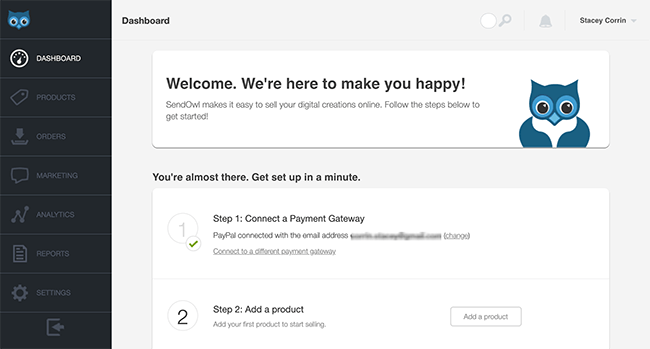
The first step is to connect a payment gateway. In my case, it automatically connected the PayPal associated with my email address. But you can change this by clicking ‘connect to a different payment gateway.
Other payment gateways include Stripe and BitPay. Click add, and you can move on to the next step.
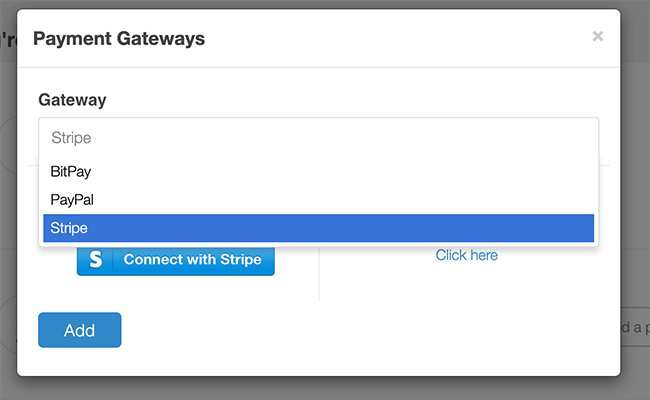
Step 2: Add your product
With your payment gateway set up, it’s time to add your first product. Click ‘Add Product’ to reveal the product options.
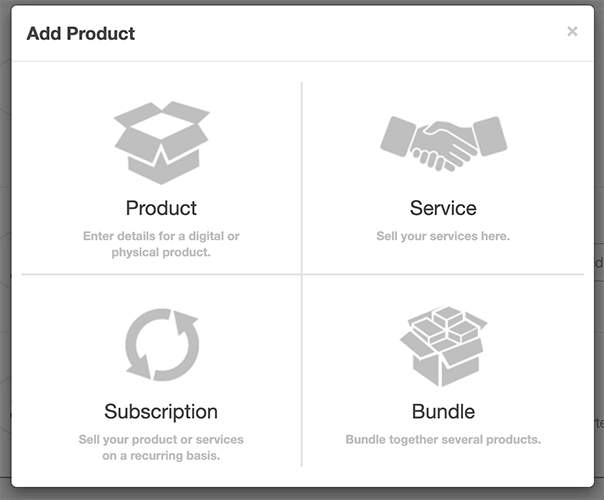
Here you can choose to sell:
- A digital or physical product
- A service
- A product or service on a recurring subscription basis
- A bundle of several products
For the purpose of this review, I’ll choose to sell a product. Selecting this option reveals the following overlay.
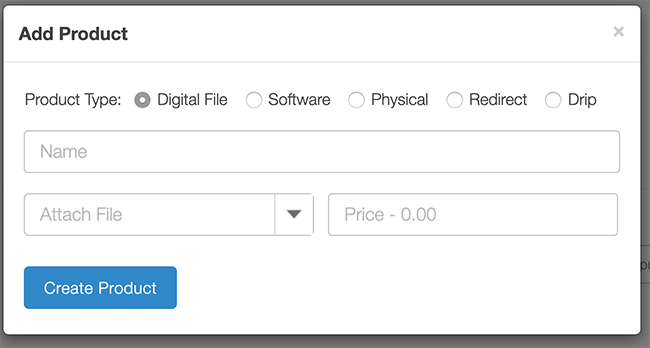
As you can see, you’re able to select the type of product, the name, the product file for Digital products and the price. Attaching the file can be done via URL too which is helpful if your product is hosted on your website.
Click ‘Create Product’ when you’re satisfied to continue. The following screen will appear.
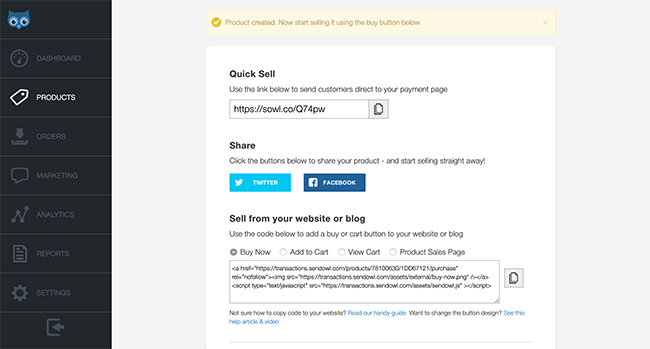
This screen provides the methods for displaying your sell buttons. You can choose the ‘Quick Sell’ option which is a short link that directs customers to your payment page or you can share it to your Twitter and Facebook pages.
If you’d prefer to sell your product from your website or blog, you can do that too. Select your button type and copy the generated code. Then paste it onto a suitable place on your site.
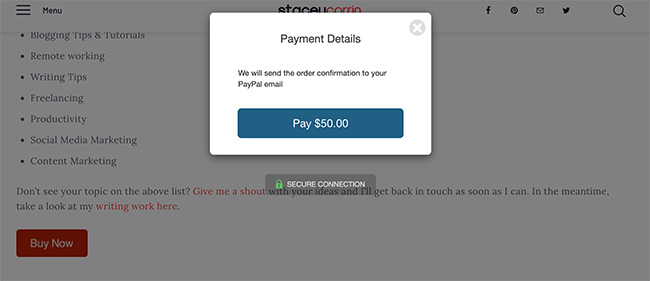
Here’s how it looks after pasting the code and clicking the ‘Buy Now’ button on my blog.
To make the sales overlay look more inviting, navigate to edit your product and click the ‘sales detail page’.
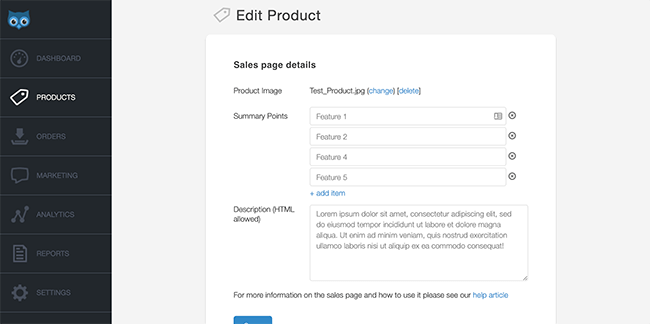
Here you can add a product image, insert feature points and create a description. By using HTML to format the description you can make some interesting style changes. Here’s my example.
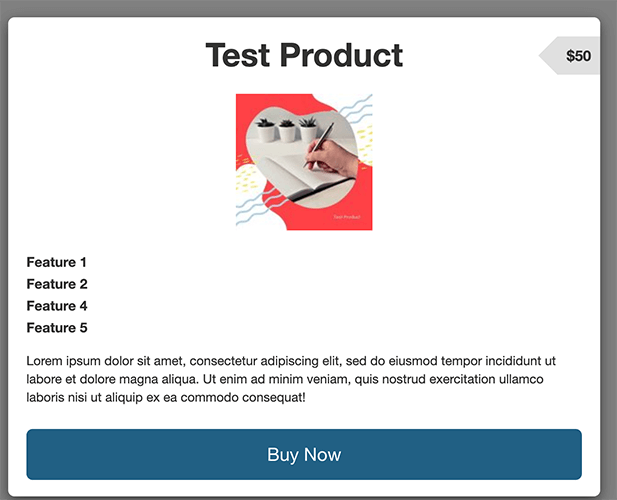
Step 3: Customisation
It’s important to mention the customisation options with SendOwl. You can customize the colours of your checkout and download pages, add your logo, and customize the emails that customers receive. All of these changes are pretty quick and easy. Let’s take a look.
Checkout customisation
From the settings page navigate to the checkout options. Here you can choose a checkout template and customise the checkout page settings.
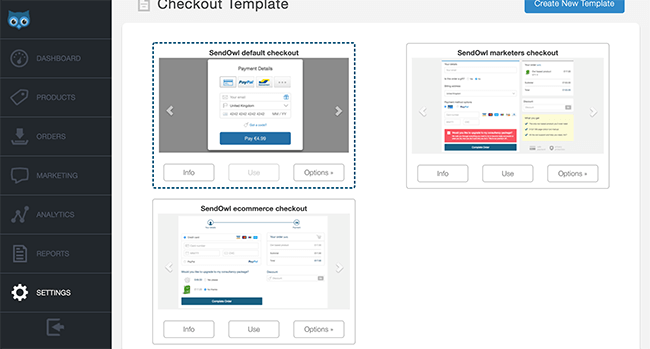
There are 3 pre-built checkout templates to choose from, each with their own professional design.
- Default checkout
- Marketers checkout
- eCommerce checkout
Each template has a number of configuration options and the ability to preview before committing.
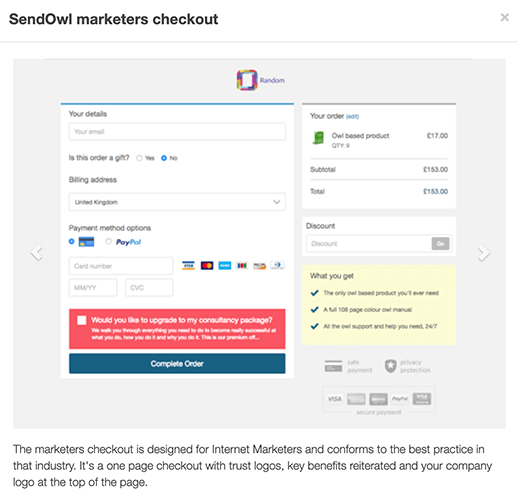
The marketer’s checkout template is particularly helpful for Internet Marketers and conforms to the best practice in that industry. It’s a one-page checkout with trust logos, key benefits reiterated and your company logo at the top of the page. There is, of course, the option to create your own template.
Email customisation
Navigating to ‘Customer Emails’ and ‘Email Templates’ allows you to view and edit the emails that go out to your customers.
These include:
- New order
- New gift order
- New subscription order
- Subscription payment notice
- Cart abandonment
- Import order
- Affiliate order and payout
- Transaction receipt
- Order dispatched
- License order
- New and updated product
- Subscription dunning cancelled and discontinued
- Claim account
- Reset password
- New affiliate membership
Each template has basic information that can easily be adapted to your needs.
Step 4: Start promoting your product
Promoting your product isn’t an automatic process. As with any form of content, you need to spend some time and effort to get the word out to your target audience.
Affiliate promotion
One of the best ways SendOwl can help with your promotion efforts is with its built-in affiliate functionality. By navigating to ‘Settings’ and ‘Affiliate Configuration’ you can set up your own affiliate program.
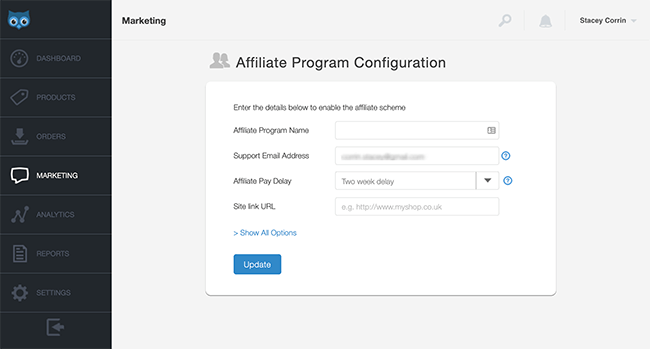
Give your program a name and an email for customer support. Then select how many days you’d like to delay payment and enter the site link URL. Advanced options allow you to set a mailing list ID, cookie preferences and terms and conditions.
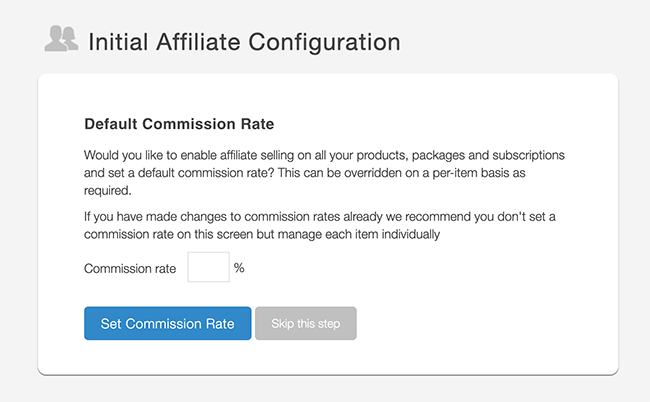
When you’ve saved your options, you can set your commission rate for affiliates. This is the percentage of the sale affiliates earn for every successful referral.
SendOwl will then do all the tracking and provide reports so you can pay your affiliates. You have full control over the details and you can also allow your affiliates to use buy now buttons directly on their site if you’d like.
Email marketing
Any good promotional campaign should include the ability to encourage customers to join your mailing list. Doing so can help you promote future products to them.
With SendOwl you can integrate the following Email Service Providers:
- ActiveCampaign
- AWeber
- CampaignMonitor
- Constant Contact
- ConvertKit
- Drip
- GetResponse
- InfusionSoft
- Mad Mimi
- MailChimp
- Sendy
- And MailerLite
Integrating with MailChimp, for example, is as simple as adding your API Key and selecting the opt-in type.
By integrating your mailing list, you’re able to add subscription options to your checkout page to further grow your list and target users already primed to take action.
Step 5: Analytics and reporting
Generating reports and detailed analytics is the best way to view customer activities. It’s also a great way to identify areas to improve and optimise your efforts.
SendOwl comes with a detailed analytics dashboard and a number of reporting options. The analytics dashboard reveals a snapshot of activity for your products.
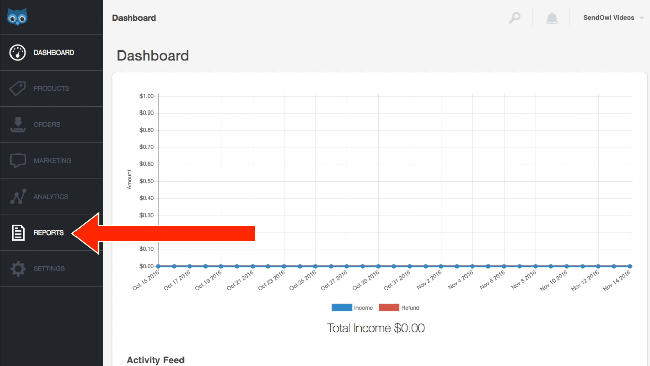
Yet navigating to ‘Reports’ provides multiple types of reporting options including reports for:
- Various order types
- EU and country-specific tax information
- Discount codes
- Affiliates
- License usage
- And Products
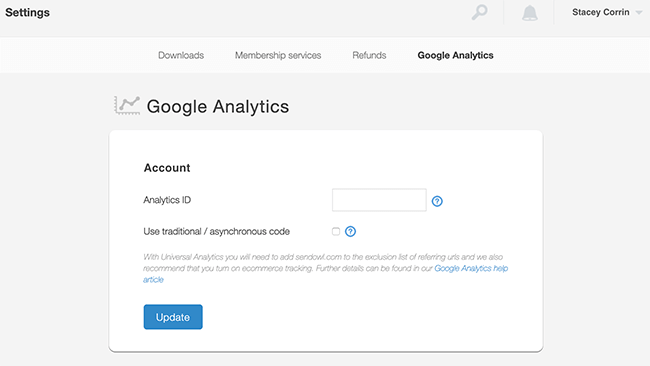
You can also connect SendOwl to Google Analytics for more detailed reporting. Navigate to ‘Settings’ and ‘Google Analytics’. Then add your Analytics ID and update to save.
How much does SendOwl cost?
Like other hosted platforms, SendOwl charges a monthly fee. Pricing starts at $9 per month on the Standard model, which allows you to sell 10 products with 1 GB of storage space. There’s no limit on the bandwidth needed for customers to download your products.
For further features you can opt for one of the following plans:
- $15 a month – 30 products and 3GB of storage
- $24 a month – 100 products and 5 GB of storage
- $39 a month – 250 products and 15 GB of storage
These prices are for their standard hosted plans. Further, plans are available for self-hosted and subscription users.
SendOwl does not charge any fees per product or per sale. The monthly fee is all you’ll pay. Of course, you will still have per-transaction fees from PayPal or whatever payment gateway you use.
SendOwl’s pros and cons
As with all eCommerce platforms, there are benefits and pitfalls to the services offered. Let’s take a look.
Pros
- Simple and easy to use
- Checkout setup is clear user-friendly
- Nice product and checkout customisation options
- One-click upsell functionality
- Built-in affiliate program
- Membership subscription functionality
- Automatically updating products
- Supports 29 currencies
- Multiple integrations with Zapier support
Cons
- Limited cryptocurrency support
- No A/B testing functionality
- No Emergency support
SendOwl Review: Final thoughts
Even with a few pitfalls, the benefits of SendOwl vastly outweigh them. There is a lot that you can do with this platform and the ease of use for both the business owners and customers is a huge selling point.
If you’re looking for an easy way to sell your products and services without the confusion of hundreds of options, I’d certainly give SendOwl a try.
What’s more, they offer a 30-day free trial so you can try it for yourself and see if it meets your needs.
